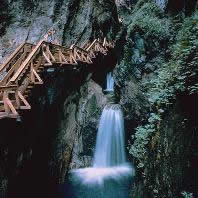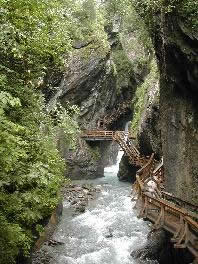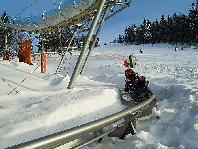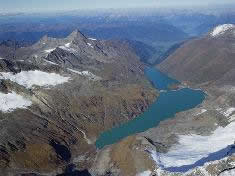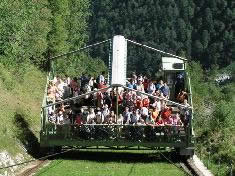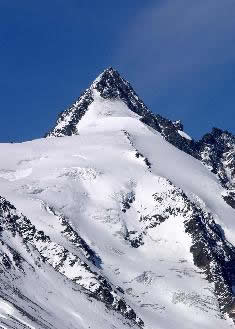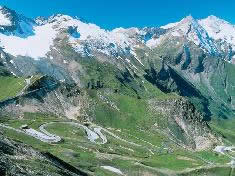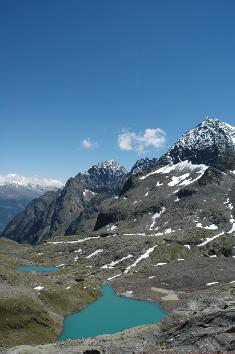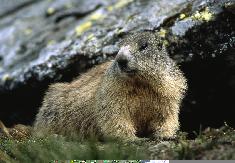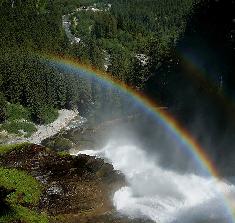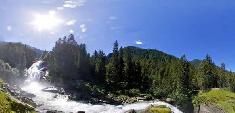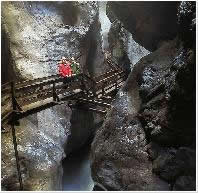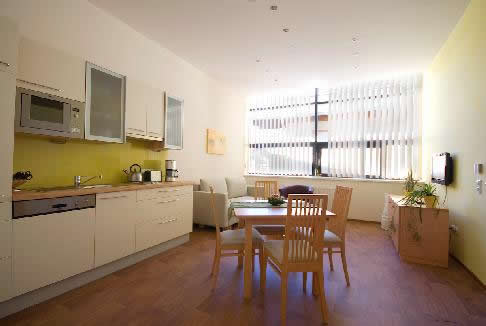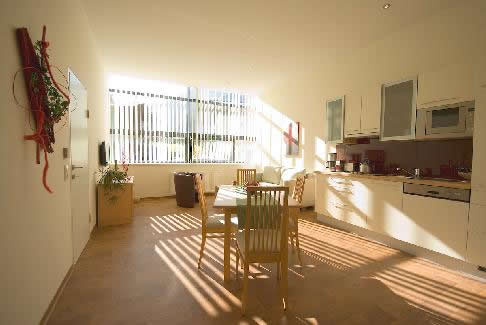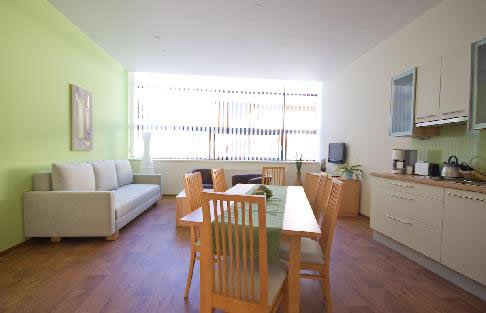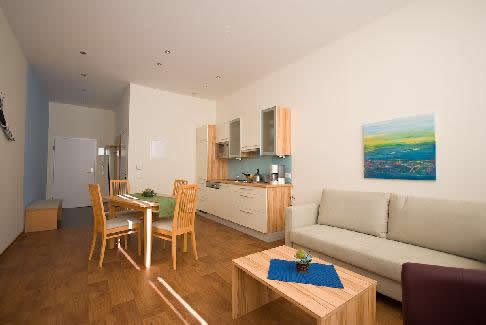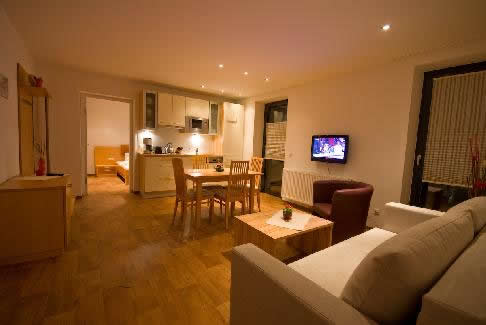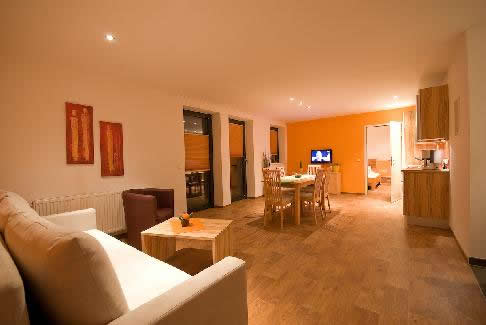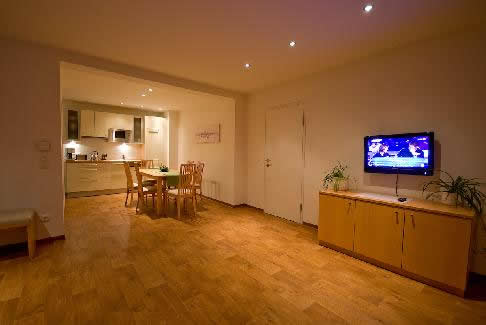Sigmund Thun Klamm
Around 14.000 years ago the valley of Kaprun was all over covered by a glacier.Slowly flowing downstream, the water of melting glaciers, the hard rocks of the Mais- and Bürgkogels processed that there are now striking and smoothing, Swirl pots and Kolk.
This still an ongoing process documented the recent Section
the genesis of Kaprun valley.
For more information: +43 (0) 6547 20019-23228
Alpin Coaster Maisiflitzer
While outside nature reawakens and the warm rays of sunshine finally melt off the snow, we are in the process of making preparations for the coming summer season.
But in the meantime we will shorten your wait, with an exhilarating ride on the Maisiflitzer. Our year-round alpine slide will stay open for your enjoyment, daily after 10:30 a.m. Exciting but safe, you will get to zoom down to the valley on a two-seater sled, reaching top speeds (controlled by you) of as much as 40 km/h.
Kaprun Alpine Reservoirs
An excursion to the Alpine reservoirs in Kaprun is a fascinating journey into the mountain world. The fresh air, the lush green of the Alpine pastures, the turquoise water of the reservoirs and the glaciers of the Hohe Tauern are deeply impressive.
The journey to the Alpine reservoirs starts at the Kesselfall Alpenhaus. The bus ride takes people through the Lärchwand tunnel to the valley terminal of the Lärchwand diagonal lift at 1,209 m above sea level.
The ride on Europe's largest open-plan diagonal lift is the first highpoint on your journey through the mountain world of Kaprun. Enjoy gliding in virtual silence past predominantly beech woodland and precipitous mountainsides to the mountain terminal at 1,640 m above sea level.
Buses waiting at the mountain terminal of the Lärchwand diagonal lift near the Limberg dam will take you past the Wasserfallboden reservoir and Fürthermoar-Alm to the Mooserboden reservoir at 2,040 m above sea level.
Find out lots of interesting facts such as how the "white gold"' of electricity is generated from water on one of the frequent guided tours of the dam walls. Between the Mooserboden and Drossen dam walls is the Electricity and Ice Adventure World, where you can find out about the world of glaciers and the construction history of the power plants.
More informations: +43 5 0313-23201
The Grossglockner - 3.798m
The Highest Mountain in Austria
At 3,798m the Grossglockner is not only the highest mountain in Austria, it also counts among the highest peaks in the Alps. The pyramid-shaped Grossglockner lies behind the slightly smaller Kleinglockner (3,770 m), separated by a saddle-like formation known as the Glocknerscharte.
The first ascent was in 1800 but victory and defeat accompanied other expeditions.
The Grossglockner and Pasterze Glacier have been owned by the Austrian Alpine Association since 1918.
With the building of the Grossglockner High Alpine Road, the majestic peak acquired a new dimension. As a popular excursion destination it is the epitome of an impressive natural experience for many people: size and power can be felt here, one is subject to the fascination of the eternal ice and the elemental force of nature.
The Grossglockner High Alpine Road
The most famous alpine road leads you into the heart of the Hohe Tauern National Park, to the highest mountain in Austria, the Grossglockner (3,798m) and its glacier, the Pasterze. You will have a driving and nature experience of a special kind on 48 kilometres of high alpine road with 36 bends, and an altitude ascent to 2,504 metres!
You pass through a unique world of mountains with blossoming alpine meadows, fragrant mountain forests, massive cliffs and eternal ice to the foot of the Grossglockner, the Kaiser-Franz-Josefs-Höhe.
The Kaiser-Franz-Josef-Höhe
The Kaiser-Franz-Josefs-Höhe is named after the visit Kaiser Franz-Josef made here in 1856. Upon arrival you stand directly before Austria´s highest mountain, the Grossglockner (3,798m), with a view of the longest glacier in the eastern Alps, the Pasterze. Marmots romp in the immediate vicinity and with a little luck you will also see the mighty ibex. The National Park Vantage Point Area with the artwork “Wellenberg with a Bronze Boat��? invites one to rest in what is certainly one of the loveliest places in the Alps. At the Visitors´Centre one is offered interesting information to all aspects of the highest mountain in Austria on four levels.
Hohe Tauern National Park - NationalparkWorlds
The largest nature reserve of the Alps ...
A wild, primeval landscape and a landscape cultivated by mountain farmers.
These are the two faces of the Hohe Tauern National Park. The nature reserve encompasses sweeping, primeval Alpine landscapes, such as glaciers, rock faces and turf, as well as mountain pasture landscapes which have been carefully and painstakingly cultivated for centuries.
The Hohe Tauern National Park was established in 1981 and is therefore Austria's first National Park. During the following decades the National Park, which covers parts of the three provinces of Carinthia, Salzburg and Tyrol, developed into the larg-est nature reserve in Central Europe, with an area of over 1,834 km2.
Discover the nature
Visit the unique world of alpine experiences focusing on Austria’s highest mountain (the Grossglockner, elev. 3,798 metres), another 266 three-thousand-metre peaks, over 342 glaciers and one of the mightiest waterfalls in the entire world. Numerous stops will take you on a walking tour through the National Park Hohe Tauern and give you the opportunity to learn about and understand the exceptional diversity on offer. Its highlights are: the Eagle's Flight Panorama, the 3D computer animation including the formation of the ´Window on the Tauern´, the Avalanche-Waterfall Dome, and the World of Glaciers.
More Information: +43 (0)6562 40939
The Krimml Waterfalls
Europe's biggest waterfalls
With a total height of 380 meters in three stages, the Krimml Waterfalls are the highest waterfalls in Europe and a unique natural wonder! The Krimml River is the source of the Krimml Waterfalls. It begins at the end of the Krimml River Valley and flows through gentle pastures before it plunges down the mighty steps as a subglacial stream. It is a 10-minute walk on the paved path installed by the Austrian Alpine Association from the WaterWonderWorld to the lowest waterfall. The waterfall path takes you to the highest waterfall (approx. 1-hour walk) and offers spectacular views of the thundering water masses.
Wonder World of water
Water is our elixir of life and has sensational capabilities. Water can work wonders and water can make these wonders visible.
Visit the Wonder World Krimml water and immerse yourself in the house of the water in the Aqua Park and in Mulitvisionskino into a fascinating world of water!
Saalachtaler Naturgewalten
Where Nature becomes an adventure ...
Within a radius of just two kilometers Pinzgau’s Saalachtal, nestled in the province of Salzburg, is home to three extraordinary natural monuments
"The natural wonders of the Saalachtal".
At the foot of both mountain ranges of Loferer and Leoganger Steinberge and the foothills of the Steinernen Meeres nature has created strangely formed rocks, rushing waterfalls and one of the largest systems of caves in Europe in the immediate vicinity.
Vorderkaserklamm
The Vorderkaserklamm between St. Martin and Weißbach was first made accessible to visitors in 1882. About 12,000 to 14,000 years ago, when the glacial ice from the last Ice Age had melted, the Ödenbach began to cut its way into the hard rock.
Today, the gorge is already 400 meters long, 80 meters deep and up to 6 meters wide at the top and a narrow 80 cm at the bottom. A total of 51 footbridges and 35 walkways with 373 steps were built into the gorge. Before reaching the entrance to the gorge (2.5 km ride from the federal road Bundesstraße 311), visitors can walk trough the nature recreation area with ponds for swimming and barbecue areas in the „Schiedergraben“.
Gorge and snack stand open
From May to October Daily from 9:30 - 18:00 clock
More informations: Phone +43 (0) 6588 8510
Lamprechtshöhle
The Lamprechtshöhle with its total length of approx. 51 kilometers is one of the largest systems of caves in Europe. Thus, the Lamprechtshöhle is presently one of the largest through caves in the world.
In the section of the cave open to visitors you can hike on easily accessible walkways about 700 meters into the mountain and conquer a difference in altitude of 70 meters to the spacious platform which offers an impressive view of most of the well-lighted part of the cave for visitors. An unforgettable experience even in inclement weather!
Cave and restaurant open all year-round
Daily from 8:30 - 18:30 clock
More Informations: Phone +43 (0) 6582 8343
Seisenbergklamm
This natural monument, the Seisenbergklamm in Weißbach bei Lofer, began to develop about 12,000 years ago when ice from the last Ice Age melted in the Alps.
In the year 1831 lumberjacks first built a track through the 600 m long gorge to transport wood.
The entrance to the gorge is located directly in town.
Gorge and snack stand open
From May to October daily from 8:30 - 18:30 clock
More informations: Phone +43 (0) 6582 8242-4 or 8352
